#gavialis gangeticus
Text
Gharial rescued from sea
Another instance of more recent croc news, a "giant" gharial was found in the Indian Ocean off the coast of Balsore, eastern India.
According to news articles, the animal, an adult Indian Gharial (Gavialis gangeticus), meassured around 13 feet or in metric close to 4 meters in length while weighing some 118 kilos.

The gharial apparently got caught in a fishing net and was found by fishermen, who promptly reported their catch to the Forest Department. The department then handed the animal over to Nandankanan Zoological Park, where the crocodilian still resides.
That's all the information given to us by the article, which you can read here, but there's two key notes I wanna touch upon.
The first is size. At 4 meters, this gharial was decently large for sure and as someone who has seen a (stuffed) female of slightly greater proportions I can attest that it must have been an impressive animal. However, I think its worth mentioning that Indian gharials are capable of growing even larger. The female I just mentioned is accompanied by a stuffed male nearly 5 and a half meters in length, with some reports claiming sizes even greater than that.
Me and the Vienna gharials

The second point is the mysterious presence of a gharial this far out at sea. This is simultaneously unusual yet also very much reasonable from the point of view of paleontology.
On the one hand, Indian gharials are critically endangered. Their range today is incrediply spotty and isolated and to my knowledge they aren't found anywhere near the coast these days.
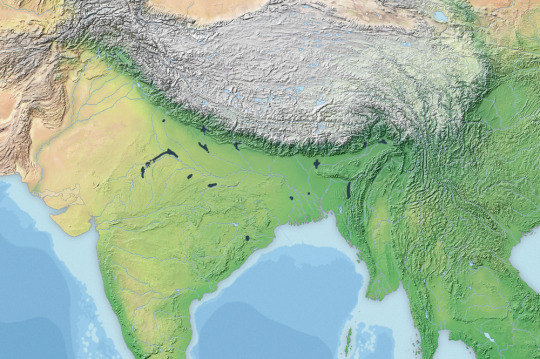

However when you look at how the range was meant to be like, then you see that they definitely reached the river deltas and coastal regions. So our image of gharials as this inland freshwater species is more based in circumstance than reality.
This becomes especially apparent once you begin to consider the paleobiogeography of gharials. Based on our current knowledge, gharials most likely originated somewhere in Eurasia or Africa, spreading from there across much of the eastern hemisphere and beyond (full disclosure I am not considering thoracosaurs to be gavialoids, more on that can of worms later maybe). Anywho, phylogenetic analysis and the fossil record both suggest that gharials then crossed oceans and settled South America sometime prior to or during the Miocene, where they diversified and gave rise to the gryposuchines. Some species even remained saltwater species, such as Piscogavialis, which lived in the coastal waters of Peru.
Although gryposuchines were once thought to be a distinct subfamily of gharial, recent research suggests that they were but an evolutionary stepping stone, with some South American form once again crossing the Pacific and settling down in Asia where the much more basal "tomistomines" or false gharials (a misnomer) still resided. And while the gryposuchines of South America went extinct, those that returned to Asia survived and eventually gave rise to the Indian Gharial of today.
Left: A cladogram showing the relationship between Gryposuchinae and modern gharials
Right: Piscogavialis swimming overhead some marine sloths of the genus Thalassocnus by @knuppitalism-with-ue


So ultimately, seeing a gharial in saltwater is much less bizarre than one would initially think, its just that habitat destruction and overhunting have largely pushed these gorgeous reptiles further inland and to the brink of extinction.
#gharial#indian gharial#gavialis gangeticus#gavialidae#news#croc#crocodilia#crocodile#india#herpetology#gavialinae#gryposuchinae#piscogavialis#some paleontology#palaeoblr
239 notes
·
View notes
Photo

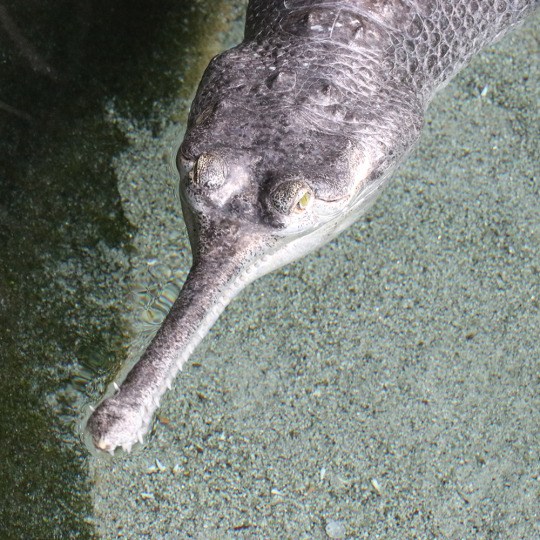
改めて信じられない形をしている
@東山動植物園
It’s an incredible shape.
@Higashiyama Zoo & Botanical Gardens
243 notes
·
View notes
Photo

The Gharial crocodile (Gavialis gangeticus) uses its slim snout for fishing.
Photo by: Josh More courtesy of ZSL.
86 notes
·
View notes
Text

Gharial (Gavialis gangeticus)
taken at the Los Angeles Zoo in Los Angeles, California
status: critically endangered
While these crocodilians can reach such intense lengths and sizes, they feed on fish and frogs which is the reason for their snout design! A thin snout like theirs makes for easier quick snatching of such small, fast prey.
#Gharial#Gavialis gangeticus#animal#reptile#photo#wildlife#photography#la zoo#los angeles zoo#zoo#canon#canon eos 6D mark ii
4 notes
·
View notes
Text

Gharials (Gavialis gangeticus), male with babies, family Gavialidae, National Chambal Gharial Wildlife Sanctuary, India
CRITICALLY ENDANGERED.
photograph by Dhritiman Mukherjee
2K notes
·
View notes
Text

Grzimek's Animal Life Encyclopedia. Volume 6: Reptiles. Written by Bernard Grzimek. 1984. Illustration by Helmut Diller.
1.) Dwarf crocodile (Osteolaemus tetraspis)
2.) False gharial (Tomistoma schlegelii)
3.) Nile crocodile (Crocodylus niloticus)
4.) American crocodile (Crocodylus acutus)
5.) Saltwater crocodile (Crocodylus porosus)
6.) Gharial (Gavialis gangeticus)
#reptiles#crocodilians#dwarf crocodiles#false gharials#nile crocodiles#american crocodiles#saltwater crocodiles#gharials#Helmut Diller
197 notes
·
View notes
Text
Mid-2022 gharial news round-up.
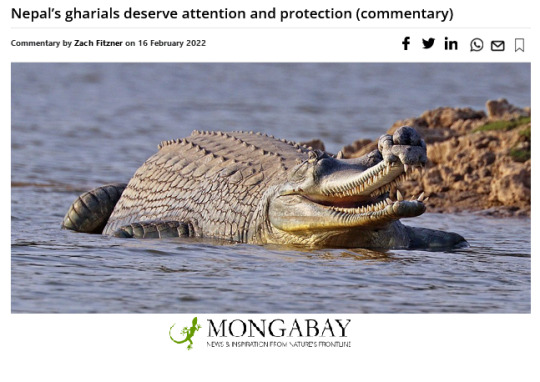
The gharial (Gavialis gangeticus, the large, conspicuous, and extremely unique fish-hunting crocodilian of the Indus, Ganges, and Brahmaputra river systems) is extinct in Bhutan, Myanmar, Bangladesh, and Pakistan. The crocodilian now only survives in small populations in India and Nepal, with perhaps only 200 breeding-capable wild adults surviving.
But now Pakistani land managers are formally requesting that Nepal provide gharials for reintroduction in the Indus river system in Pakistan, where they’ve been extinct for nearly 40 years. [Source: Abhaya Raj Joshi. “Return of the king? Pakistan moves to bring gharials from Nepal to its rivers.” Mongabay. 2 July 2022.]



---
For the first time in nearly 20 years, new wild-born gharial hatchlings have been spotted in critical gharial habitat in Nepal’s Karnali River. [Source: Abhaya Raj Joshi. “First gharial hatchlings spotted in nearly two decades in Nepal’s Karnali River.” Mongabay. 20 June 2022.]

---
In 2016, it was discovered for the first time that gharials had been successfully nesting in the Gandak river system. After the release of another 148 gharials, as of 2022, it has been determined that the Gandak river is now home to the second-largest population of gharials in India. [Source: Patna News. “‘Gandak now second largest gharial population in country.’“ As published at The Hindustan Times. 3 July 2022.]

---
More discussion of wild gharial hatchlings in Nepal. [Source: Abhaya Raj Joshi. “New gharial hatchlings in Nepal a hopeful sign for the critically endangered reptile.” Mongabay India. 28 June 2022.]

---
Reintroduced gharials are expected to begin successfully breeding in the wild in the Punjab. [Source: Vikas Vasudeva. “Reintroduced gharials thriving in Beas reserve: experts.” The Hindu. 18 December 2021.]

---
For context.
Historical distribution range of the gharial:

And current distribution range.
Gharials are now extinct in Pakistan, Bhutan, Myanmar, and Bangladesh:

172 notes
·
View notes
Text

🟪 ANIMAL OF THE DAY: gharial. Gavialis gangeticus. lives in India and is the longest of all Crocodile species. what is it doing with all that Long? i do not know
50 notes
·
View notes
Text
Uncharismatic Fact of the Day
No, that’s not a disfigured crocodile-- that’s a gharial! These crocodilians are named after their distinctive snouts, which resemble earthenware pots called ‘ghara’ made in their native India and Pakistan. Males use their growths to amplify mating calls underwater and to blow bubbles that attract females.
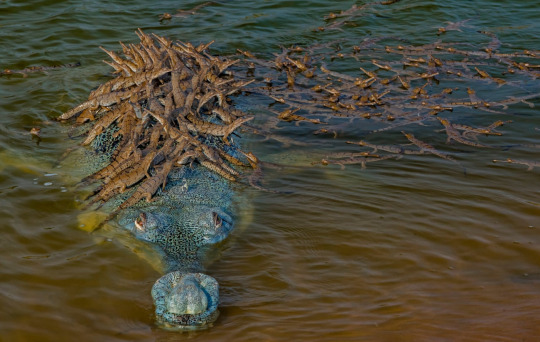
(Image: A proud gharial (Gavialis gangeticus) dad, by Dhritiman Mukherjee)
If you like what I do, consider buying me a ko-fi!
107 notes
·
View notes
Text
Hello everyone! Damn, the paddlefish article has really brought a lot of new folks to this blog! Welcome everyone, and thank you so much for joining this lovely little project of mine--I am so grateful that so many people have taken an interest in my work and in the species I want to help protect.
Since there are so many new folks here, I wanted to give a brief rundown on the articles I've written so far. In the last year and a half of this project, I've been able to write about seventeen awesome and unique species that are in need of further conservation attention. Here are some links to learn more about them:
Olm (Proteus anguinus): the OG and mascot for the site, this eyeless salamander manages to survive in its pitch-dark cave biome through incredible sensory abilities and supernatural patience.
Indian Purple Frog (Nasikabatrachus sahyadrensis): this comically-ugly creature is also incredibly mysterious, spending its entire life underground and only emerging for a single day each year.
Pygmy Hippo (Choeropsis liberiensis): this secretive, pig-sized mammal is the only surviving relative of the mighty river hippo, but lives a completely different lifestyle from its much more famous cousin.
Scaly-Foot Snail (Chrysomallon squamiferum): one of the weirdest animals on the planet, this snail grows a shell reinforced with iron and lives around hydrothermal vents deep beneath the surface of the Indian ocean.
Kaua'i Cave Wolf Spider (Adelocosa anops): this blind cave spider is one of the rarest arthropods on Earth, and lives in tunnels carved by lava flows beneath the surface of the Hawaiian Island of Kaua'i.
Shoebill (Balaeniceps rex): this huge African water bird uses its tremendous beak like a guillotine to smash and decapitate its prey.
Largetooth Sawfish (Pristis pristis): this relative of sharks and rays has a tremendous nose lined with teeth which it uses to dig up and swipe at prey, but that's not the only thing its nose is good for.
Takin (Budorcas taxicolor): this large goat relative is quite possibly the most mysterious large land mammal on Earth, as it lives deep in the forested mountains of China, India, and Bhutan.
Zacatuche (Romerolagus diazi): also known as the "volcano rabbit", this adorable little fellow is an excellent gateway into understanding the benefits of grasslands to ecosystems and human settlements alike. Done in collaboration with Mexico'a CONANP.
(tambien en español)
Secretarybird (Sagittarius serpentarius): this badass raptor stalks the African savannah, using its powerful legs to deliver one of the fastest and most accurate kicks in the animal kingdom (and yes it's also the bird from Aggretsuko).
Manchineel (Hippomane mancinella): the first plant written about on Consider Nature (though certainly not the last), the manchineel is quite possibly the most toxic tree in the world, with every part of its anatomy steeped with a variety of noxious substances.
Gharial (Gavialis gangeticus): this crocodilian is a fish specialist, using its long, slender snout like a rapier to cut through the water and snag its prey.
Vaquita (Phocoena sinus): the most-endangered mammal on the face of the Earth, the Vaquita is a tiny porpoise that has gotten caught up in the black market trade of an extremely valuable fish bladder. Done in collaboration with Sea Shepherd International.
Pekapeka (Mystacina tuberculata): this tiny bat species is one of only 2 mammals native to New Zealand and spends more time on the ground than any other bat species in the world, despite being able to fly.
Angular Roughshark (Oxynotus centrina): this shark is native to the coasts of Western Europe and Africa, where it lives over a thousand feet beneath the waves and is rarely seen by people.
Marine Iguana (Amblyrhynchus cristatus): these iguanas are the only seafaring lizards in the world, and have developed a variety of remarkable adaptations to survive the extreme conditions of the Galapagos Islands.
And as always, if you have any suggestions, questions, or just want to say hi, you can DM me here or email me at [email protected]. Welcome, and thank you for your support.
4 notes
·
View notes
Text
Animal of the Day!
Gharial (Gavialis gangeticus)
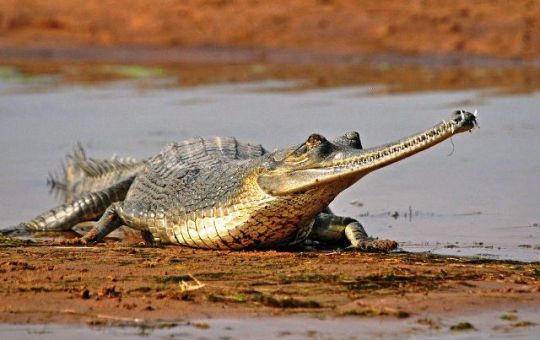
(Photo from Animal Spot)
Conservation Status- Critically Endangered
Habitat- India; Nepal; Bangladesh
Size (Weight/Length)- 150 kg; 6 m
Diet- Fish; Insects; Frogs
Cool Facts- Despite their intimidating size and massive teeth, gharials are completely harmless to humans. Usually only eating fish, gharials are relatively passive and will not go after large mammals because their snouts are so thin. They live in small groups and only leave water to bask in the sun for heat. Gharials have an extensive courting process but the female does most of the work. She builds a large nest out of reeds and water plants and she will take care of her hatchlings for several months by carrying them around on her back. Due to hunting and pollution, gharials are one of the most endangered crocodilian.
Rating- 12/10 (Snippy snappy goes the big ‘ole croc teeth.)
#Animal of the day#Animals#Reptile#Crocodile#Saturday#May 14#Gharial#biology#science#conservation#the more you know
143 notes
·
View notes
Text
Animal Crossing Fish - Explained #195
Brought to you by a marine biologist and the biggest, baddest reptiles alive right now...
CLICK HERE FOR THE AC FISH EXPLAINED MASTERPOST!
By the time you read this, I will be out at sea, but I wanted to do these guys because I just did an educational program about crocodilians on Saturday and I guess I wasn’t done? Yeah, so, let’s talk about the Alligator Villagers, okay?
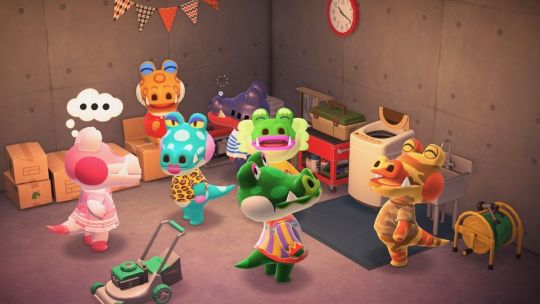
This is going to be a long ass post because I’m about to share almost everything I know about crocodilians and show lots of pictures, because I absolutely love them.
Now, just to get this out of the way, two of the Alligator Villagers are not really crocodilians - Drago is a Dragon and Del is a robot. And unfortunately, none of the Alligator villagers look like any particular species of crocodilian, which is a damn shame. In fact, they don’t really resemble Alligators as much as they do Crocodiles (and, in fact, in the Japanese version, they are called Crocodiles).
But I hear you asking “how the hell can you tell?” Glad you asked! See, there are actually 4 major kinds of Crocodilian - Alligators, Caimans, Crocodiles, and the Gharial. They all belong in the Order Crocodilia, which is a group of animals that were actually incredibly diverse in the distant past. Back then, crocs didn’t just wallow around in the water waiting to ambush prey - a good lot of them had strong legs allowing them to hold their bodies off the ground and *run* after prey. They filled many niches and some were so big they preyed upon dinosaurs. Of course, like many animals at the end of the Cretaceous some 66 million years ago, many crocs went extinct, but this tried and true playbook of ambushing from the water stayed around.
Today, crocs are found primarily in tropical areas around the world. There are 2 species of alligator, 14 species of crocodile, 6 species of caiman, and 2 species of gharial. Quite a few of them are endangered due to habitat loss, harvest for their tough skins, and people generally being afraid of them.
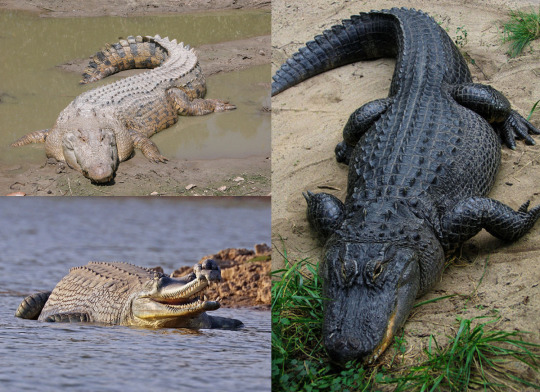
By LittleJerry - derivative work:File:SaltwaterCrocodile('Maximo').jpg Molly Ebersold of the St. Augustine Alligator FarmFile:American Alligator.jpg User:PostdlfFile:Gharial (Gavialis gangeticus) male.jpg Charlesjsharp, CC BY-SA 4.0, https://commons.wikimedia.org/w/index.php?curid=75191082
Okay, but back to the original question - how to tell these animals apart? They all have the same general body plan - a thick, muscular body, a big flat tail for swimming, eyes and nostrils at the top of their heads, and four splayed out legs they clumsily use to drag themselves around on land. So, when telling them apart, you want to look at the shape of their snouts! Alligators have a very broad snout (pic to the right), and most of their teeth, especially the lower jaw set, are hidden. Meanwhile, crocodiles have longer, pointier snouts and many of their teeth, top and bottom, stick out of their mouths (which makes the Alligator villagers actually Crocodiles with those teeth protruding from the lower jaw).
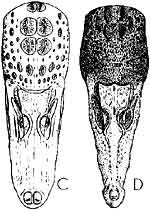
After that, it gets more simple - Caiman are the smallest of the crocodilians and have short snouts, and, although they are more closely related to Alligators, they are more crocodile-like with their sharper teeth and pointier snout. Last but not least is my favorite, the very strange Gharials, with their very skinny snout and long, needle-like teeth perfect for catching fish.

By Clpramod - Own work, CC BY-SA 4.0, https://commons.wikimedia.org/w/index.php?curid=78302378
Okay, so where do Crocodilians fall on the tree of life? Are they just really big lizards? NO. In fact, crocodilians belong in a clade called the archosaurs, a separate lineage of reptiles from the lepidosaurs, aka the snakes, lizards, and plesiosaurs, etc. Archosaurs include not only crocs, but also the pterosaurs and all of the dinosaurs. That last bit means that crocs and birds are more closely related to each other than they are to snakes and lizards. We’re also pretty sure turtles belong in archosauria, but that’s still considered tentative, though there’s been more evidence to support it. So, yeah, crocodiles and birds, cousins.
Now, let’s talk about the business end of a croc - those teeth! All croc teeth have one function - to hold onto prey and basically get abused as the animals use them to drag larger animals into the water to drown. The teeth are sharp, but they are also thick and robust, perfect for this purpose. They are also built to withstand the incredible power crocodile jaws have to offer - the absolute strongest jaws of any animal alive today belong to the saltwater croc - allowing crocs to not only bite and hold onto prey, but also crush it, really. In that way, the teeth are more like spikes than teeth, since they do not slice or help the animal chew. Crocs swallow their prey or prey chunks whole. The only slight deviation in this plan is the gharial that has thinner teeth for a specialized diet of fish, but it still stands - the teeth are for holding onto prey.
I think I’ll stop there, but yeah, crocs are cool af!
See ya later, alligator!
#alligator#crocodile#caiman#gharial#reptiles#animal crossing#animal crossing villagers#biology#animal crossing fish explained
12 notes
·
View notes
Text

The Gharial crocodile, scientifically known as Gavialis gangeticus, is a truly unique and remarkable reptile. It's instantly recognizable by its long, slender snout lined with approximately 110 sharp teeth. This specialized snout sets it apart from other crocodilians and is adapted for its primary diet of fish. Adult males of the species can reach impressive lengths of up to 23 feet, making them among the largest freshwater predators in India. Gharials are primarily found in the rivers of India, where they play a vital role in maintaining the aquatic ecosystem by controlling fish populations. Despite their fearsome appearance, Gharials are generally not a threat to humans due to their limited snout opening, but it's still wise to exercise caution around these intriguing reptiles. Unfortunately, this unique species faces conservation challenges, and efforts are being made to protect and preserve their dwindling populations in the wild.
0 notes
Text
Do you know
Some important Gharial facts.
A native of the Indian subcontinent, the gharial (Gavialis gangeticus), is a critically endangered species of turtle. They are mostly found in northern India's river systems, with the Ganges, Brahmaputra, and Mahanadi river basins having the largest population. principal source of food for gharials is fish, which they catch with the help of their long, narrow snouts, which are full of sharp, interlocking teeth. Gharials can reach a maximum length of 20 feet (6 meters) as adults, although females are typically shorter, growing to a maximum length of 14 feet (4.5 meters). follow www.banzaaratravels.com to get real experience related to wildlife.
1 note
·
View note
Text

Gharial (Gavialis gangeticus)
taken at the Los Angeles Zoo in Los Angeles, California
status: critically endangered
One of the Gharials at the LA zoo again! They're slowly growing larger but still have much more growing to do. Once adults males can be between 9.8 and 16 feet while females can reach 8.9 to 12 feet!
#Gharial#Gavialis gangeticus#reptile#animal#wildlife#critically endangered#la zoo#los angeles zoo#zoo#photo#photography#canon#canon eos 6D mark ii
1 note
·
View note
Text
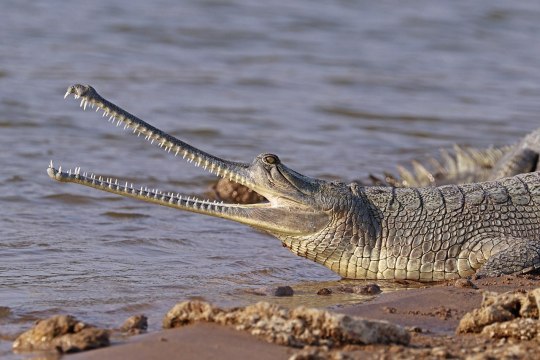
Gharial (Gavialis gangeticus), female, family Gavialidae, National Chambal Sanctuary, India
CRITICALLY ENDANGERED.
photograph by Charles J. Sharp
297 notes
·
View notes